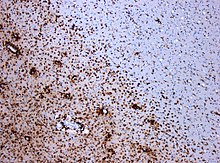
Back داء مزيل للميالين Arabic Demijelinizirajuće bolesti BS Malaltia desmielinitzant Catalan Demyelinisierende Erkrankung German Απομυελίνωση Greek بیماری میلینزدا Persian Doenza desmielinizante Galician Demielinasi ID Malattia demielinizzante Italian 脱髄疾患 Japanese
| Demyelinating disease | |
|---|---|
 | |
| Photomicrograph of a demyelinating MS-lesion: Immunohistochemical staining for CD68 highlights numerous macrophages (brown). Original magnification 10×. | |
| Specialty | Neurology |
A demyelinating disease refers to any disease affecting the nervous system where the myelin sheath surrounding neurons is damaged.[1] This damage disrupts the transmission of signals through the affected nerves, resulting in a decrease in their conduction ability. Consequently, this reduction in conduction can lead to deficiencies in sensation, movement, cognition, or other functions depending on the nerves affected.
Various factors can contribute to the development of demyelinating diseases, including genetic predisposition, infectious agents, autoimmune reactions, and other unknown factors. Proposed causes of demyelination include genetic predisposition, environmental factors such as viral infections or exposure to certain chemicals. Additionally, exposure to commercial insecticides like sheep dip, weed killers, and flea treatment preparations for pets, which contain organophosphates, can also lead to nerve demyelination.[2] Chronic exposure to neuroleptic medications may also cause demyelination.[3] Furthermore, deficiencies in vitamin B12 can result in dysmyelination.[4][5]
Demyelinating diseases are traditionally classified into two types: demyelinating myelinoclastic diseases and demyelinating leukodystrophic diseases. In the first group, a healthy and normal myelin is destroyed by toxic substances, chemicals, or autoimmune reactions. In the second group, the myelin is inherently abnormal and undergoes degeneration.[6] The Poser criteria named this second group dysmyelinating diseases.[7]
In the most well-known demyelinating disease, multiple sclerosis, evidence suggests that the body's immune system plays a significant role. Acquired immune system cells, specifically T-cells, are found at the site of lesions. Other immune system cells, such as macrophages (and possibly mast cells), also contribute to the damage.[8]
- ^ "demyelinating disease" at Dorland's Medical Dictionary
- ^ Lotti M, Moretto A (2005). "Organophosphate-induced delayed polyneuropathy". Toxicol Rev. 24 (1): 37–49. doi:10.2165/00139709-200524010-00003. PMID 16042503. S2CID 29313644.
- ^ Konopaske GT, Dorph-Petersen KA, Sweet RA, Pierri JN, Zhang W, Sampson AR, Lewis DA (April 2008). "Effect of chronic antipsychotic exposure on astrocyte and oligodendrocyte numbers in macaque monkeys". Biol Psychiatry. 63 (8): 759–65. doi:10.1016/j.biopsych.2007.08.018. PMC 2386415. PMID 17945195.
- ^ Agadi S, Quach MM, Haneef Z (2013). "Vitamin-responsive epileptic encephalopathies in children". Epilepsy Res Treat. 2013: 510529. doi:10.1155/2013/510529. PMC 3745849. PMID 23984056.
- ^ Yoganathan S, Varman M, Oommen SP, Thomas M (2017). "A Tale of Treatable Infantile Neuroregression and Diagnostic Dilemma with Glutaric Aciduria Type I". J Pediatr Neurosci. 12 (4): 356–359. doi:10.4103/jpn.JPN_35_17. PMC 5890558. PMID 29675077.
- ^ Fernández O, Fernández VE, Guerrero M (2015). "Demyelinating diseases of the central nervous system". Medicine. 11 (77): 4601–4609. doi:10.1016/j.med.2015.04.001.
- ^ POSER CM (March 1961). "Leukodystrophy and the concept of dysmyelination". Arch Neurol. 4 (3): 323–32. doi:10.1001/archneur.1961.00450090089013. PMID 13737358.
- ^ Laetoli (January 2008). "Demyelination". Archived from the original on 2012-07-28.
© MMXXIII Rich X Search. We shall prevail. All rights reserved. Rich X Search